2021年中考英语二轮复习课件-名词专题 (共34张PPT)
文档属性
| 名称 | 2021年中考英语二轮复习课件-名词专题 (共34张PPT) |
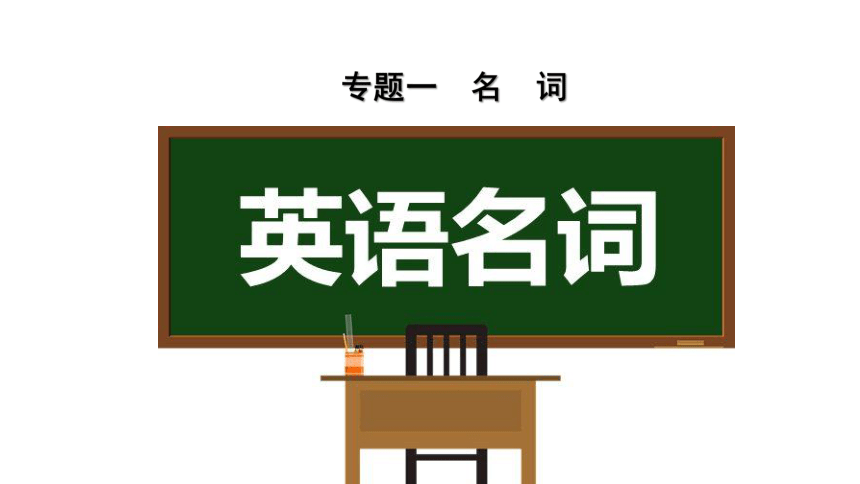
|
|
| 格式 | ppt | ||
| 文件大小 | 874.0KB | ||
| 资源类型 | 教案 | ||
| 版本资源 | 外研版 | ||
| 科目 | 英语 | ||
| 更新时间 | 2021-05-27 09:55:49 | ||
图片预览

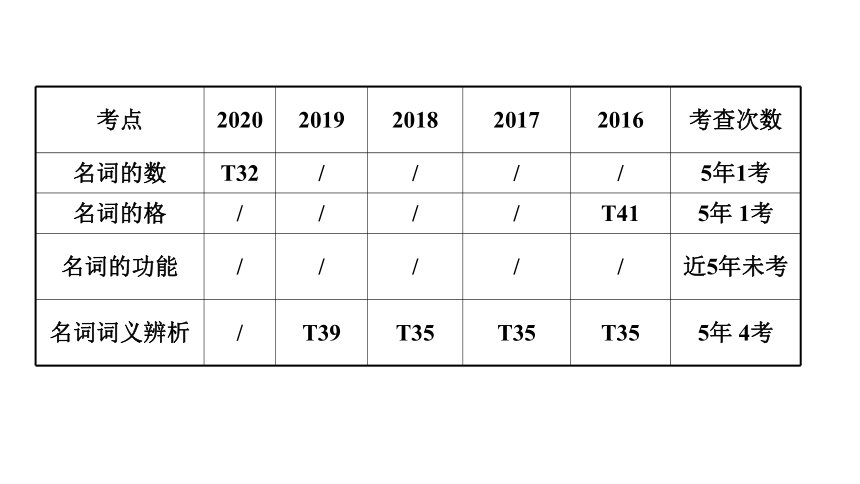

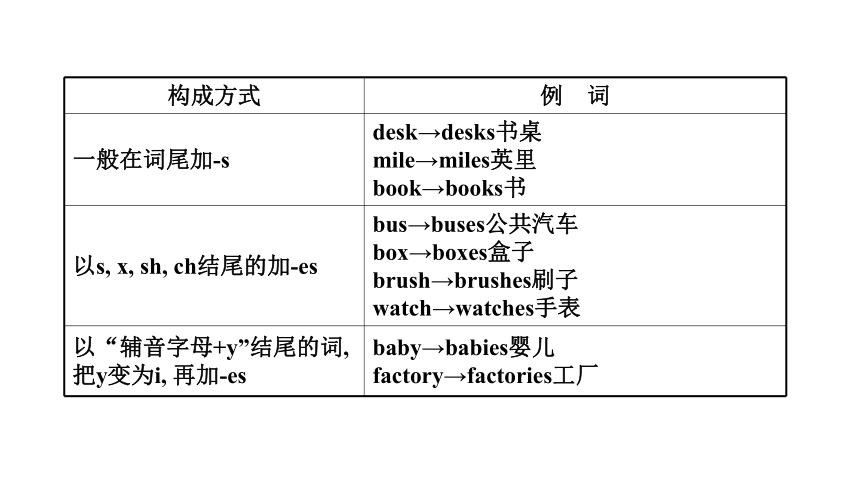
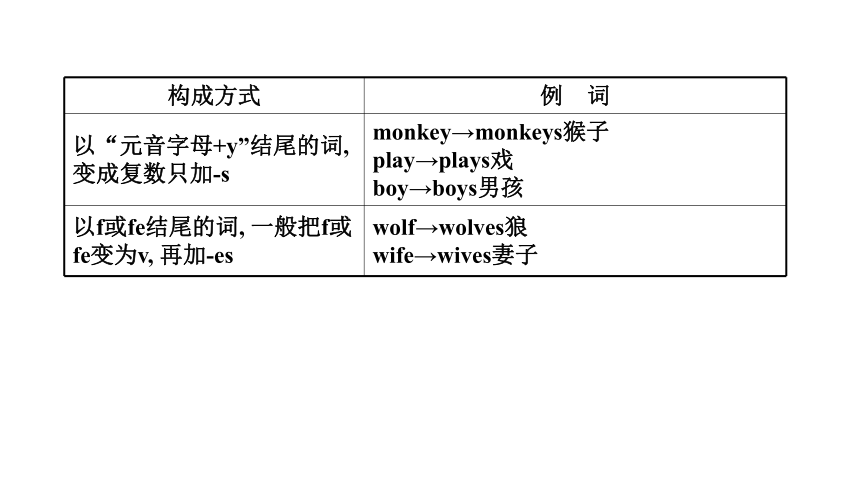
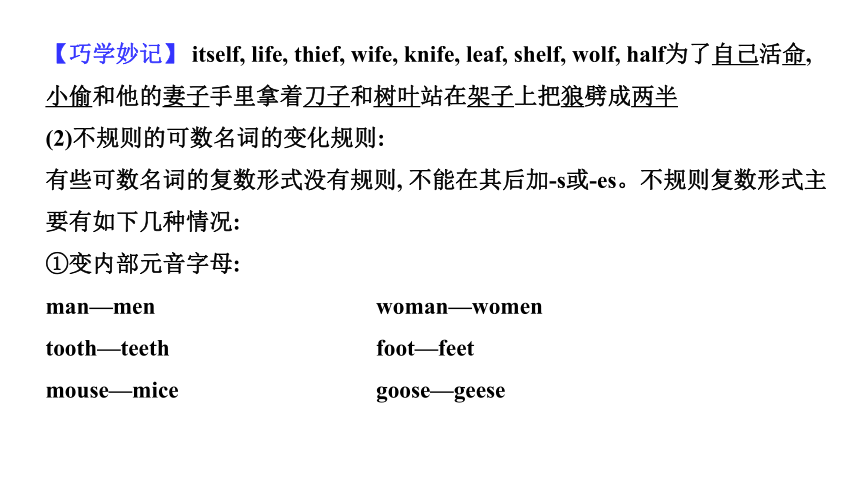
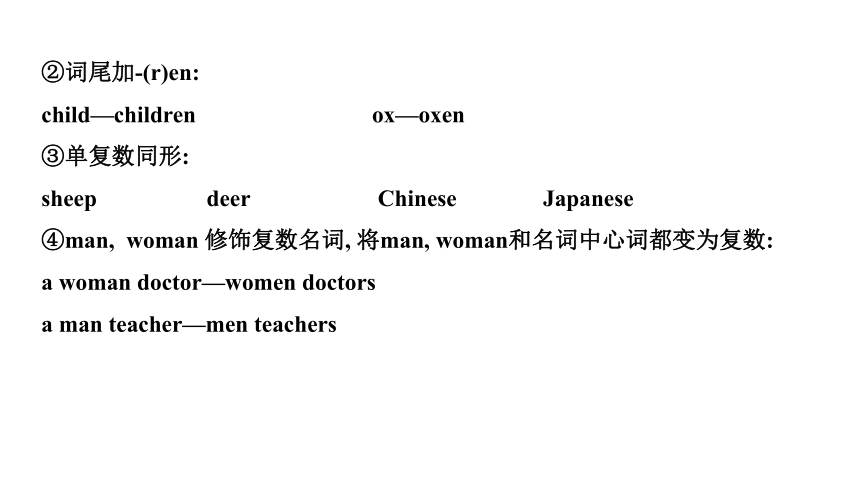

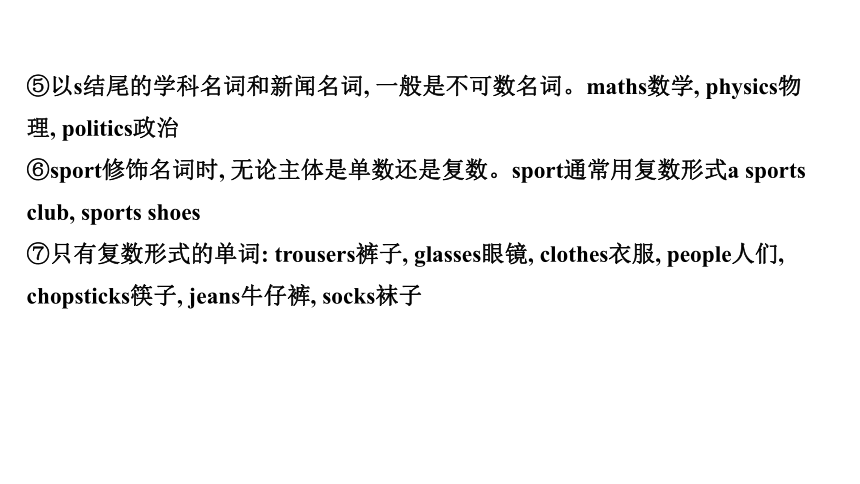
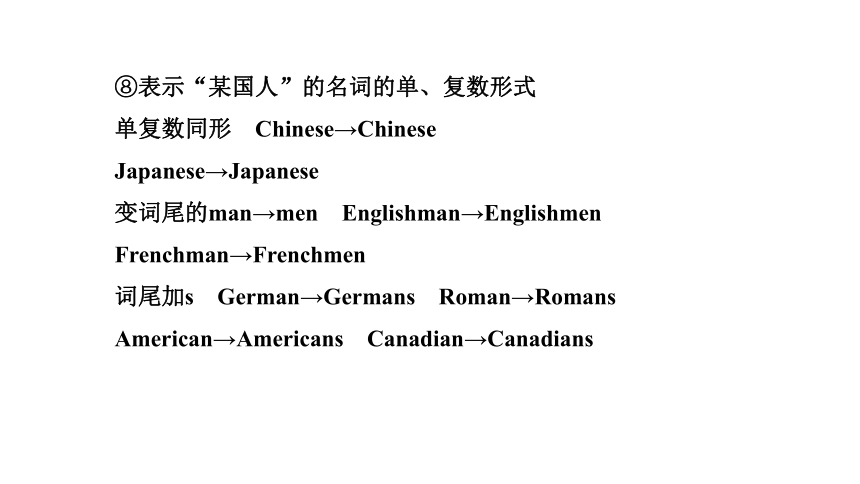
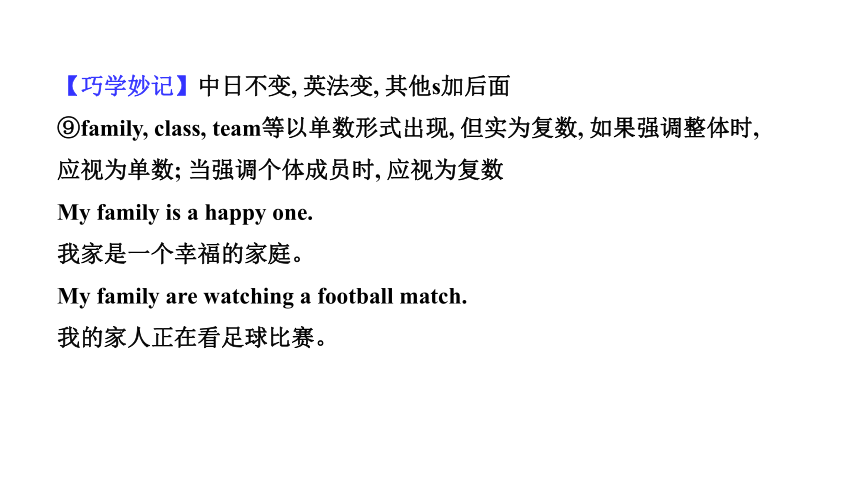

文档简介
专题一 名 词
柳州五年中考考情
考点
2020
2019
2018
2017
2016
考查次数
名词的数
T32
/
/
/
/
5年1考
名词的格
/
/
/
/
T41
5年 1考
名词的功能
/
/
/
/
/
近5年未考
名词词义辨析
/
T39
T35
T35
T35
5年 4考
考点解读·疑难精析
一、名词的数
可数名词都有单数和复数之分; 不可数名词没有复数形式。
1. 可数名词
(1)规则的可数名词的复数变化规则:
构成方式
例 词
一般在词尾加-s
desk→desks书桌
mile→miles英里
book→books书
以s, x, sh, ch结尾的加-es
bus→buses公共汽车
box→boxes盒子
brush→brushes刷子
watch→watches手表
以“辅音字母+y”结尾的词, 把y变为i, 再加-es
baby→babies婴儿
factory→factories工厂
构成方式
例 词
以“元音字母+y”结尾的词, 变成复数只加-s
monkey→monkeys猴子
play→plays戏
boy→boys男孩
以f或fe结尾的词, 一般把f或fe变为v, 再加-es
wolf→wolves狼
wife→wives妻子
【巧学妙记】 itself, life, thief, wife, knife, leaf, shelf, wolf, half为了自己活命, 小偷和他的妻子手里拿着刀子和树叶站在架子上把狼劈成两半
(2)不规则的可数名词的变化规则:
有些可数名词的复数形式没有规则, 不能在其后加-s或-es。不规则复数形式主要有如下几种情况:
①变内部元音字母:
man—men woman—women
tooth—teeth foot—feet
mouse—mice goose—geese
②词尾加-(r)en:
child—children ox—oxen
③单复数同形:
sheep deer Chinese Japanese
④man, woman 修饰复数名词, 将man, woman和名词中心词都变为复数:
a woman doctor—women doctors
a man teacher—men teachers
【温馨提示】
以o结尾的单词, 多加-s。例如: radio→radios收音机; photo →photos相片; piano→pianos钢琴。但potato→potatoes土豆; tomato→tomatoes西红柿; hero→heroes英雄, 这三个词后要加-es。我们可以巧记为“英雄吃西红柿拌土豆, 有意思(es)”。?
⑤以s结尾的学科名词和新闻名词, 一般是不可数名词。maths数学, physics物理, politics政治
⑥sport修饰名词时, 无论主体是单数还是复数。sport通常用复数形式a sports club, sports shoes
⑦只有复数形式的单词: trousers裤子, glasses眼镜, clothes衣服, people人们, chopsticks筷子, jeans牛仔裤, socks袜子
⑧表示“某国人”的名词的单、复数形式
单复数同形 Chinese→Chinese
Japanese→Japanese
变词尾的man→men Englishman→Englishmen
Frenchman→Frenchmen
词尾加s German→Germans Roman→Romans
American→Americans Canadian→Canadians
【巧学妙记】中日不变, 英法变, 其他s加后面
⑨family, class, team等以单数形式出现, 但实为复数, 如果强调整体时,
应视为单数; 当强调个体成员时, 应视为复数
My family is a happy one.
我家是一个幸福的家庭。
My family are watching a football match.
我的家人正在看足球比赛。
【易错提醒】
①fish表示鱼的种类时复数形式是fishes, 表示条数而不强调种类时,
单复数同形用fish。
There are many kinds of fishes in this river.
这条河中有很多不同种类的鱼。
I caught five fish today.
我今天捉了5条鱼。
②有一些名词是成双、成对出现的, 这些名词常用pair来修饰。
a pair of glasses一副眼镜
a pair of trousers一条裤子
a pair of shoes一双鞋
a pair of gloves一副手套
a pair of pants一条裤子
a pair of shorts一条短裤
a pair of scissors一把剪刀
2. 不可数名词
(1)不可数名词分为五类:
①肉类meat, beef, chicken, mutton, pork, fish
②液体类water, tea, rain, milk, orange, coffee, juice
③语言类Chinese, Japanese, English, French, German
④材料类glass, grass, bamboo, paper, hair, silk, cotton, plastic, wood, salt
⑤其他类advice, homework, housework, information, traffic, news, money, bread, weather, snow, ice, rice, food
(2)一般情况下不可数名词没有复数形式, 如果想表示数量, 我们可以用名词单位词来表示, 常用的单位词有: piece, bit, bottle, cup, glass等。
a piece of advice一条建议 a bit of bread一点面包
a bottle of water一瓶水 a cup of coffee一杯咖啡
a glass of milk一杯牛奶
( )①There are lots of______on the farm. ?
A. sheep B. pig C. horse
( )②Could you please give me______? ?
A. an advice B. some advices C. some advice
A
C
( )③There are______on the desk. ?
A. two piece of paper
B. two pieces of paper
C. two piece of papers
B
二、名词的所有格
1. ’s所有格
构成方法
示 例
单数名词一般在词尾加’s
The girl’s school bag is nice.
那个女孩的书包很漂亮。
以s结尾的复数名词加“’”
The teachers’ office is over there. 老师们的办公室在那里。
不以s结尾的复数名词加 ’s
There are many children’s books in the shop. 在这家商店里有许多儿童读物。
构成方法
示 例
表示两个人共有同一物, 只在后一个名词词尾加’s; 如果两个人分别拥有某物, 则在两个名词词尾后分别加’s(被修饰名词要用复数形式)
This is Tom and Peter’s room. 这是汤姆和彼得共同的房间。
These are Tom’s and Peter’s shoes.
这些是汤姆和彼得的鞋子。
表示时间、距离、国家、地点和自然现象等无生命的事物的名词也可以在词尾加’s构成所有格
today’s paper
今天的报纸
2. of所有格
①of所有格一般用于表示无生命的东西的名词。
a map of the world一张世界地图
the windows of the room房间的窗户
②表示有生命的东西, 有时也可以用of所有格。
the children of that family
那家的孩子们
3. 双重所有格
’s所有格和of所有格两种所有格形式结合在一起, 构成双重所有格。
a good friend of mine我的一个好朋友
a friend of Henry’s亨利的一个朋友
【易错提醒】
不定冠词、数词、某些不定代词(some, any, many, no, few等)以及which等限定词, 一般不与形容词性物主代词或’s所有格等一起放在名词前修饰名词, 而采用of所有格或双重所有格形式。
I have read some books of his. 我读过他的一些书。
Which book of Qiong Yao’s have you read?
你读过琼瑶的哪一本书?
【巧学妙记】
名词所有格, 表示“……的”, 一般要把’s加,
复数词尾有s, 只加“’”就可以,
名词若为物无生命, 常把of所有格来应用,
一物若被两者所共有, 只在最后一个加“’s”,
时间、地点和距离, 所有格也可用’s。
( )①—______bookcase is this? ?
—It must be______. ?
A. Who’s; Tom B. Who’s; Tom’s C. Whose; Tom’s
( )②Sue has many nice dresses. She wears a different one every day______the week. ?
A. of B. from C. at
C
A
( )③—Whose room is this?
—It’s______. ?
A. Lucy and Lily B. Lucy and Lily’s
C. Lucy’s and Lily’s
( )④The leaves______the tree turn green in spring. ?
A. in B. of C. at
B
B
( )⑤In China, we celebrate______Day on June 1st and ______Day
on September 10th. ?
A. Children’s; Teacher’s B. Children; Teachers
C. Children’s; Teachers’
C
【易错提醒】
特殊名词, 如表示度量衡、时间、距离、金额等的复数名词作主语时,
谓语动词往往用单数。
Two hours is enough for me to finish the work.
对我来说完成这项工作两个小时足够了。
三、名词的功能
1. 作主语
My father teaches them English. ?
我爸爸教他们英语。
【易错提醒】
①名词作定语时, 一般用单数形式。
a shoe factory tomato and egg noodles
②有些名词需要用复数形式作定语。
a clothes shop a sports meet
2. 作定语
There are many banana trees in Hainan. ?
海南有许多香蕉树。
( )①The pair of trousers ______me. I will take it. ?
A. fit B. fits C. will fit D. can’t fit
( )②Fifty yuan ______enough. ?
A. is B. am C. are D. be
( )③—What would you like for breakfast?
—I’d like ______. ?
A. tomato noodle B. tomato noodles
C. tomatoes noodle D. tomatoes noodles
B
A
B
( )④Our school has fifty-six______teachers. ?
A. woman B. women
C. woman’s D. womens’
B
四、名词词义辨析
考查具体语言环境下词义的区别, 解答此类题目要知道不同的名词表达的
具体含义, 以及能辨析它们之间的差异, 这就需要准确记忆名词词义, 并在活生
生的语言环境中来学习名词。
( )①—Someone called you just now.
—I know. But I was busy at that moment. When I called back, there was
no______. ?
A. voice B. sound C. answer
( )②Just search the Internet, and you can get almost all the______you
need. ?
A. informations B. information C. picture
C
B
( )③—Hello! Is that Jenny speaking?
—Sorry, I’m afraid you’ve got the wrong______. ?
A. number B. name C. address
( )④Tom is in good health, because he often exercises and eats a lot of
healthy ______. ?
A. food B. water C. pear
( )⑤—It’s a wise______to wear the white tie. It matches your shirt well. ?
—Thank you very much.
A. choice B. support C. mixture
A
A
A
柳州五年中考考情
考点
2020
2019
2018
2017
2016
考查次数
名词的数
T32
/
/
/
/
5年1考
名词的格
/
/
/
/
T41
5年 1考
名词的功能
/
/
/
/
/
近5年未考
名词词义辨析
/
T39
T35
T35
T35
5年 4考
考点解读·疑难精析
一、名词的数
可数名词都有单数和复数之分; 不可数名词没有复数形式。
1. 可数名词
(1)规则的可数名词的复数变化规则:
构成方式
例 词
一般在词尾加-s
desk→desks书桌
mile→miles英里
book→books书
以s, x, sh, ch结尾的加-es
bus→buses公共汽车
box→boxes盒子
brush→brushes刷子
watch→watches手表
以“辅音字母+y”结尾的词, 把y变为i, 再加-es
baby→babies婴儿
factory→factories工厂
构成方式
例 词
以“元音字母+y”结尾的词, 变成复数只加-s
monkey→monkeys猴子
play→plays戏
boy→boys男孩
以f或fe结尾的词, 一般把f或fe变为v, 再加-es
wolf→wolves狼
wife→wives妻子
【巧学妙记】 itself, life, thief, wife, knife, leaf, shelf, wolf, half为了自己活命, 小偷和他的妻子手里拿着刀子和树叶站在架子上把狼劈成两半
(2)不规则的可数名词的变化规则:
有些可数名词的复数形式没有规则, 不能在其后加-s或-es。不规则复数形式主要有如下几种情况:
①变内部元音字母:
man—men woman—women
tooth—teeth foot—feet
mouse—mice goose—geese
②词尾加-(r)en:
child—children ox—oxen
③单复数同形:
sheep deer Chinese Japanese
④man, woman 修饰复数名词, 将man, woman和名词中心词都变为复数:
a woman doctor—women doctors
a man teacher—men teachers
【温馨提示】
以o结尾的单词, 多加-s。例如: radio→radios收音机; photo →photos相片; piano→pianos钢琴。但potato→potatoes土豆; tomato→tomatoes西红柿; hero→heroes英雄, 这三个词后要加-es。我们可以巧记为“英雄吃西红柿拌土豆, 有意思(es)”。?
⑤以s结尾的学科名词和新闻名词, 一般是不可数名词。maths数学, physics物理, politics政治
⑥sport修饰名词时, 无论主体是单数还是复数。sport通常用复数形式a sports club, sports shoes
⑦只有复数形式的单词: trousers裤子, glasses眼镜, clothes衣服, people人们, chopsticks筷子, jeans牛仔裤, socks袜子
⑧表示“某国人”的名词的单、复数形式
单复数同形 Chinese→Chinese
Japanese→Japanese
变词尾的man→men Englishman→Englishmen
Frenchman→Frenchmen
词尾加s German→Germans Roman→Romans
American→Americans Canadian→Canadians
【巧学妙记】中日不变, 英法变, 其他s加后面
⑨family, class, team等以单数形式出现, 但实为复数, 如果强调整体时,
应视为单数; 当强调个体成员时, 应视为复数
My family is a happy one.
我家是一个幸福的家庭。
My family are watching a football match.
我的家人正在看足球比赛。
【易错提醒】
①fish表示鱼的种类时复数形式是fishes, 表示条数而不强调种类时,
单复数同形用fish。
There are many kinds of fishes in this river.
这条河中有很多不同种类的鱼。
I caught five fish today.
我今天捉了5条鱼。
②有一些名词是成双、成对出现的, 这些名词常用pair来修饰。
a pair of glasses一副眼镜
a pair of trousers一条裤子
a pair of shoes一双鞋
a pair of gloves一副手套
a pair of pants一条裤子
a pair of shorts一条短裤
a pair of scissors一把剪刀
2. 不可数名词
(1)不可数名词分为五类:
①肉类meat, beef, chicken, mutton, pork, fish
②液体类water, tea, rain, milk, orange, coffee, juice
③语言类Chinese, Japanese, English, French, German
④材料类glass, grass, bamboo, paper, hair, silk, cotton, plastic, wood, salt
⑤其他类advice, homework, housework, information, traffic, news, money, bread, weather, snow, ice, rice, food
(2)一般情况下不可数名词没有复数形式, 如果想表示数量, 我们可以用名词单位词来表示, 常用的单位词有: piece, bit, bottle, cup, glass等。
a piece of advice一条建议 a bit of bread一点面包
a bottle of water一瓶水 a cup of coffee一杯咖啡
a glass of milk一杯牛奶
( )①There are lots of______on the farm. ?
A. sheep B. pig C. horse
( )②Could you please give me______? ?
A. an advice B. some advices C. some advice
A
C
( )③There are______on the desk. ?
A. two piece of paper
B. two pieces of paper
C. two piece of papers
B
二、名词的所有格
1. ’s所有格
构成方法
示 例
单数名词一般在词尾加’s
The girl’s school bag is nice.
那个女孩的书包很漂亮。
以s结尾的复数名词加“’”
The teachers’ office is over there. 老师们的办公室在那里。
不以s结尾的复数名词加 ’s
There are many children’s books in the shop. 在这家商店里有许多儿童读物。
构成方法
示 例
表示两个人共有同一物, 只在后一个名词词尾加’s; 如果两个人分别拥有某物, 则在两个名词词尾后分别加’s(被修饰名词要用复数形式)
This is Tom and Peter’s room. 这是汤姆和彼得共同的房间。
These are Tom’s and Peter’s shoes.
这些是汤姆和彼得的鞋子。
表示时间、距离、国家、地点和自然现象等无生命的事物的名词也可以在词尾加’s构成所有格
today’s paper
今天的报纸
2. of所有格
①of所有格一般用于表示无生命的东西的名词。
a map of the world一张世界地图
the windows of the room房间的窗户
②表示有生命的东西, 有时也可以用of所有格。
the children of that family
那家的孩子们
3. 双重所有格
’s所有格和of所有格两种所有格形式结合在一起, 构成双重所有格。
a good friend of mine我的一个好朋友
a friend of Henry’s亨利的一个朋友
【易错提醒】
不定冠词、数词、某些不定代词(some, any, many, no, few等)以及which等限定词, 一般不与形容词性物主代词或’s所有格等一起放在名词前修饰名词, 而采用of所有格或双重所有格形式。
I have read some books of his. 我读过他的一些书。
Which book of Qiong Yao’s have you read?
你读过琼瑶的哪一本书?
【巧学妙记】
名词所有格, 表示“……的”, 一般要把’s加,
复数词尾有s, 只加“’”就可以,
名词若为物无生命, 常把of所有格来应用,
一物若被两者所共有, 只在最后一个加“’s”,
时间、地点和距离, 所有格也可用’s。
( )①—______bookcase is this? ?
—It must be______. ?
A. Who’s; Tom B. Who’s; Tom’s C. Whose; Tom’s
( )②Sue has many nice dresses. She wears a different one every day______the week. ?
A. of B. from C. at
C
A
( )③—Whose room is this?
—It’s______. ?
A. Lucy and Lily B. Lucy and Lily’s
C. Lucy’s and Lily’s
( )④The leaves______the tree turn green in spring. ?
A. in B. of C. at
B
B
( )⑤In China, we celebrate______Day on June 1st and ______Day
on September 10th. ?
A. Children’s; Teacher’s B. Children; Teachers
C. Children’s; Teachers’
C
【易错提醒】
特殊名词, 如表示度量衡、时间、距离、金额等的复数名词作主语时,
谓语动词往往用单数。
Two hours is enough for me to finish the work.
对我来说完成这项工作两个小时足够了。
三、名词的功能
1. 作主语
My father teaches them English. ?
我爸爸教他们英语。
【易错提醒】
①名词作定语时, 一般用单数形式。
a shoe factory tomato and egg noodles
②有些名词需要用复数形式作定语。
a clothes shop a sports meet
2. 作定语
There are many banana trees in Hainan. ?
海南有许多香蕉树。
( )①The pair of trousers ______me. I will take it. ?
A. fit B. fits C. will fit D. can’t fit
( )②Fifty yuan ______enough. ?
A. is B. am C. are D. be
( )③—What would you like for breakfast?
—I’d like ______. ?
A. tomato noodle B. tomato noodles
C. tomatoes noodle D. tomatoes noodles
B
A
B
( )④Our school has fifty-six______teachers. ?
A. woman B. women
C. woman’s D. womens’
B
四、名词词义辨析
考查具体语言环境下词义的区别, 解答此类题目要知道不同的名词表达的
具体含义, 以及能辨析它们之间的差异, 这就需要准确记忆名词词义, 并在活生
生的语言环境中来学习名词。
( )①—Someone called you just now.
—I know. But I was busy at that moment. When I called back, there was
no______. ?
A. voice B. sound C. answer
( )②Just search the Internet, and you can get almost all the______you
need. ?
A. informations B. information C. picture
C
B
( )③—Hello! Is that Jenny speaking?
—Sorry, I’m afraid you’ve got the wrong______. ?
A. number B. name C. address
( )④Tom is in good health, because he often exercises and eats a lot of
healthy ______. ?
A. food B. water C. pear
( )⑤—It’s a wise______to wear the white tie. It matches your shirt well. ?
—Thank you very much.
A. choice B. support C. mixture
A
A
A
同课章节目录
- 词法
- 名词
- 动词和动词短语
- 动词语态
- 动词时态
- 助动词和情态动词
- 非谓语动词
- 冠词
- 代词
- 数词和量词
- 形容词副词及其比较等级
- 介词和介词短语
- 连词和感叹词
- 构词法
- 相似、相近词比较
- 句法
- 陈述句
- 一般疑问句和否定疑问句
- 特殊疑问句及选择疑问句
- 反意疑问句
- 存在句(There be句型)
- 宾语从句
- 定语从句
- 状语从句
- 主谓一致问题
- 简单句
- 并列句
- 复合句
- 主谓一致
- 主、表语从句
- 名词性从句
- 直接引语和间接引语
- 虚拟语气
- 感叹句
- 强调句
- 倒装句
- 祈使句
- 句子的成分
- 句子的分类
- 题型专区
- 单项选择部分
- 易错题
- 完形填空
- 阅读理解
- 词汇练习
- 听说训练
- 句型转换
- 补全对话
- 短文改错
- 翻译
- 书面表达
- 任务型阅读
- 语法填空
- 其他资料
